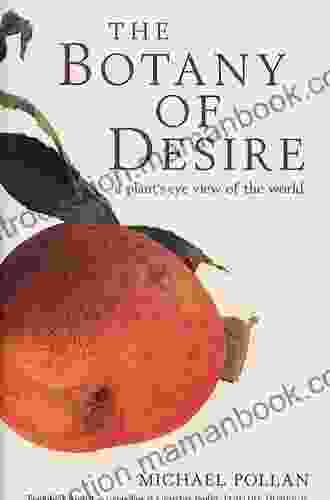A Plant's-Eye View of the World: Understanding the Unique Sensory Perception of Plants

4.7 out of 5
| Language | : | English |
| File size | : | 691 KB |
| Text-to-Speech | : | Enabled |
| Screen Reader | : | Supported |
| Enhanced typesetting | : | Enabled |
| Word Wise | : | Enabled |
| Print length | : | 304 pages |
In the vibrant tapestry of life, plants occupy a realm of their own, possessing a complex and sophisticated ability to perceive and respond to their environment. Despite lacking the traditional sensory organs of animals, plants exhibit a remarkable capacity to sense and interpret a wide range of stimuli, from the gentle caress of a breeze to the subtle fluctuations in light intensity.
This article takes a deep dive into the fascinating world of plant perception, exploring the unique ways plants sense and process information from their surroundings. By unraveling the intricate mechanisms underlying plant sensory perception, we gain a deeper appreciation for the extraordinary adaptive strategies employed by these photosynthetic masters.
Sensing Light
Light is the lifeblood of plants, providing the energy they need to perform photosynthesis and grow. Plants possess sophisticated photoreceptors that allow them to detect and respond to different wavelengths of light.
- Chlorophyll: The primary photoreceptor responsible for photosynthesis. Chlorophyll molecules absorb blue and red light, converting it into chemical energy.
- Phytochromes: Photoreceptors that sense red and far-red light. They play a crucial role in regulating seed germination, flowering, and other plant developmental processes.
- Cryptochromes: Photoreceptors that sense blue and ultraviolet light. They regulate circadian rhythms and other light-dependent responses.
Perceiving Touch
Plants are remarkably sensitive to touch, using specialized touch-sensitive cells called mechanoreceptors. These cells respond to physical deformation, allowing plants to detect mechanical stimuli like wind, rain, and animal contact.
- Thigmomorphogenesis: Plants can modify their growth and development in response to touch. For example, vines use tendrils to cling to supports, while some plants strengthen their stems in response to wind.
- Trap plants: Carnivorous plants, such as Venus flytraps, use mechanoreceptors to detect the presence of insects. When an insect touches the trap, it triggers a rapid closure, trapping the prey.
Hearing the Unheard
While plants do not have ears, they possess the ability to detect and respond to sound vibrations. This acoustic perception plays an essential role in plant communication and defense.
- Sound localization: Some plants, such as sunflowers, can orient their leaves and flowers towards the source of sound. This behavior may be an adaptive mechanism to maximize light capture.
- Herbivore deterrence: Plants can emit ultrasonic sounds when attacked by insects. These sounds can attract predators that feed on the insects, providing a defense against herbivory.
Sensing Gravity and Magnetic Fields
Plants possess specialized cells called statocytes that allow them to sense gravity. These cells contain starch-filled organelles called amyloplasts, which settle at the bottom of the cell due to gravity. The position of the amyloplasts provides information about the plant's orientation in space.
In addition to gravity, some plants also show sensitivity to magnetic fields. This magnetic sense enables them to align their stems and leaves along the Earth's magnetic field lines.
Chemical Communication
Plants release and detect chemical signals to communicate with each other and with other organisms in their environment. These chemical cues play a vital role in plant growth, defense, and reproduction.
- Phytohormones: Plants produce hormones that regulate various aspects of growth and development. These hormones can be transported through the plant's tissues or released into the environment to affect neighboring plants.
- Allelopathy: Some plants release chemicals that inhibit the growth of nearby plants. This competition strategy can give them a competitive advantage in nutrient-poor environments.
Beyond the Sense Organs
The sensory capabilities of plants extend beyond the traditional senses of touch, hearing, and smell. Plants possess a remarkable ability to perceive and respond to a wide range of other stimuli, including:
- Electric fields: Plants can detect and respond to electric fields generated by lightning, other plants, and even animals.
- Water stress: Plants have sophisticated mechanisms to sense and respond to water shortages. They can adjust their metabolism, close their stomata, and alter their root growth to adapt to water scarcity.
- Pollination cues: Flowers use visual, olfactory, and tactile cues to attract pollinators. These cues help ensure the successful transfer of pollen, essential for plant reproduction.
The world of plant perception is a fascinating and complex one, filled with intricate mechanisms and awe-inspiring adaptations. From sensing light and gravity to communicating through chemical signals, plants exhibit a remarkable capacity to perceive and respond to their surroundings. By unraveling the mysteries of plant sensory perception, we gain a deeper appreciation for the extraordinary abilities of these photosynthetic wonders.
As we continue to explore the plant kingdom, we can expect to uncover even more fascinating insights into their sensory capabilities. This knowledge will not only enhance our understanding of plant biology but also inspire innovations that mimic plant sensory systems for various applications in science and technology.
4.7 out of 5
| Language | : | English |
| File size | : | 691 KB |
| Text-to-Speech | : | Enabled |
| Screen Reader | : | Supported |
| Enhanced typesetting | : | Enabled |
| Word Wise | : | Enabled |
| Print length | : | 304 pages |
Do you want to contribute by writing guest posts on this blog?
Please contact us and send us a resume of previous articles that you have written.
 Top Book
Top Book Novel
Novel Fiction
Fiction Nonfiction
Nonfiction Literature
Literature Paperback
Paperback Hardcover
Hardcover E-book
E-book Audiobook
Audiobook Bestseller
Bestseller Classic
Classic Mystery
Mystery Thriller
Thriller Romance
Romance Fantasy
Fantasy Science Fiction
Science Fiction Biography
Biography Memoir
Memoir Autobiography
Autobiography Poetry
Poetry Drama
Drama Historical Fiction
Historical Fiction Self-help
Self-help Young Adult
Young Adult Childrens Books
Childrens Books Graphic Novel
Graphic Novel Anthology
Anthology Series
Series Encyclopedia
Encyclopedia Reference
Reference Guidebook
Guidebook Textbook
Textbook Workbook
Workbook Journal
Journal Diary
Diary Manuscript
Manuscript Folio
Folio Pulp Fiction
Pulp Fiction Short Stories
Short Stories Fairy Tales
Fairy Tales Fables
Fables Mythology
Mythology Philosophy
Philosophy Religion
Religion Spirituality
Spirituality Essays
Essays Critique
Critique Commentary
Commentary Glossary
Glossary Bibliography
Bibliography Index
Index Table of Contents
Table of Contents Preface
Preface Introduction
Introduction Foreword
Foreword Afterword
Afterword Appendices
Appendices Annotations
Annotations Footnotes
Footnotes Epilogue
Epilogue Prologue
Prologue Olivia Wildenstein
Olivia Wildenstein C S Fritz
C S Fritz David Rabe
David Rabe B F Accardi
B F Accardi Youme Inoue
Youme Inoue Nina G
Nina G Feng Jie
Feng Jie De Andre Salter
De Andre Salter Eiman O Zein Elabdin
Eiman O Zein Elabdin Matthew Fallesen
Matthew Fallesen Luciana Lee
Luciana Lee Alan Shepard
Alan Shepard Cadijah Crenshaw
Cadijah Crenshaw Avijit Mathur
Avijit Mathur Dan Whitehead
Dan Whitehead Morris Panych
Morris Panych Garrett Hongo
Garrett Hongo Hicham And Mohamed Ibnalkadi
Hicham And Mohamed Ibnalkadi A L Herbert
A L Herbert Sharone Stevens
Sharone Stevens
Light bulbAdvertise smarter! Our strategic ad space ensures maximum exposure. Reserve your spot today!

 Jerry HayesHow to Successfully Sell Real Estate to Russians: A Comprehensive Guide for...
Jerry HayesHow to Successfully Sell Real Estate to Russians: A Comprehensive Guide for...
 Maurice ParkerCrochet Pattern Roses and Lace Girl Sundress PA708: A Guide to Creating a...
Maurice ParkerCrochet Pattern Roses and Lace Girl Sundress PA708: A Guide to Creating a... Greg CoxFollow ·10.9k
Greg CoxFollow ·10.9k Jason HayesFollow ·4.7k
Jason HayesFollow ·4.7k Jamal BlairFollow ·13.2k
Jamal BlairFollow ·13.2k Carter HayesFollow ·5.1k
Carter HayesFollow ·5.1k William WordsworthFollow ·10.8k
William WordsworthFollow ·10.8k Elias MitchellFollow ·5k
Elias MitchellFollow ·5k Kazuo IshiguroFollow ·2.5k
Kazuo IshiguroFollow ·2.5k Carson BlairFollow ·8.7k
Carson BlairFollow ·8.7k

 Floyd Powell
Floyd PowellTutoring the Player Campus Wallflowers: A Comprehensive...
College campuses are...

 Chuck Mitchell
Chuck MitchellThe Beginner's Guide to Building, Repairing, Raising, and...
Credit is a...

 Deacon Bell
Deacon BellDelve into the Dangerous World of Motorrad Clubs with the...
Prepare yourself...

 Adrien Blair
Adrien BlairDiscover the Enchanting Allure of Living in the...
The Appalachian Forest, a verdant tapestry of...
4.7 out of 5
| Language | : | English |
| File size | : | 691 KB |
| Text-to-Speech | : | Enabled |
| Screen Reader | : | Supported |
| Enhanced typesetting | : | Enabled |
| Word Wise | : | Enabled |
| Print length | : | 304 pages |











